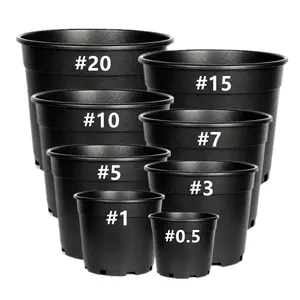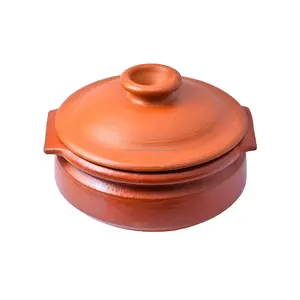(1869 products available)

























































































































































































Handi pots are traditional cooking pots native to India. They are typically made from clay or metal and have a wide base, a narrow neck, and a large mouth. They are used for various cooking methods, including simmering, stewing, and slow cooking. Here's an overview of the types of handi pots:
Clay Handis:
Traditional handi pots are made of clay. They give food a unique flavor and keep it warm. Clay handis are often used for dishes like biryani, dal, and curries. They are great for cooking in a natural and healthy way. Clay handi pots are popular in Indian homes and restaurants because they make food taste better and keep it nutritious.
Brass Handis:
Brass handi pots combine clay and metal, using brass for the metal part. Brass is good for cooking because it spreads heat evenly and is strong and durable. Mixing brass with clay makes the pot even better for cooking. Brass handi pots are great for making biryani, curries, and stews. Using brass for the pot helps keep the food's natural taste and nutrients. These pots are also healthy to use because brass is safe for food. Brass handi pots are stylish and useful in kitchens and restaurants.
Stainless Steel Handis:
Handi pots made from stainless steel are strong, last a long time, and do not rust. They do not react with acidic or alkaline foods, keeping the food safe to eat. Their durability and ease of maintenance make them a preferred choice for many households and restaurants. Stainless steel handi pots distribute heat well, making them suitable for various dishes, including biryanis, curries, and slow-cooked stews.
Aluminum Handis:
Handi pots made from aluminum are lightweight and conduct heat well. They are affordable and resist corrosion, making them suitable for everyday cooking. Aluminum handi pots evenly distribute heat, making them ideal for dishes that require consistent cooking temperatures, such as biryanis and slow-cooked curries. They are a common choice in many kitchens due to their practicality and cost-effectiveness.
Copper Handis:
Handi pots made from copper are known for their excellent heat conductivity. Copper handi pots heat quickly and evenly, making them suitable for various cooking tasks. They can often be used on open flames or induction cooktops, making them versatile. Copper handi pots are also valued for their durability and ability to retain heat, making them ideal for dishes that benefit from consistent cooking temperatures.
Handi pots have traditional designs that reflect cultural heritage and craftsmanship, making them suitable for both cooking and serving. The design incorporates several elements, as discussed below.
Shape:
Handi pot shapes vary. Most have broad bases and narrow openings, promoting even heat distribution and retention. Traditional handis are round, symbolizing unity and harmony. Modern ones may have square or rectangular pots for contemporary cooking needs.
Materials:
Handi pots are primarily made from clay. Traditional pottery clay handi is natural and adds unique flavors to food. It is suitable for slow cooking and retains heat well. Clay handi pots are safe for health. They do not react with food. Metal handi pots use stainless steel, copper, or aluminum. They are more durable and have a reactive non-stick coating for faster cooking. The materials used in handi pots are chosen for their ability to enhance cooking, maintain heat, and provide a safe and healthy cooking environment.
Craftsmanship:
Traditional clay handis are crafted through artisanal potting. Artisans shape the pot by hand or with a potter's wheel and bake it in a kiln. Copper and brass handis are intricately engraved or hammered by skilled metalworkers. Each handi reflects its maker's skill and cultural traditions. The handi pot design involves decorative elements that show regional style. Traditional clay handis may have simple designs. Metal handis often have ornate patterns, including floral motifs and geometric shapes.
Functionality:
Handi pots are versatile. Clay handis can be used on gas stoves, open fires, or in tandoors. Metal handis are compatible with modern cooktops, including induction. The design promotes slow cooking. It is ideal for making curries, biryanis, and stews, improving flavors and tenderness. The wide opening and shape of handi pots make them ideal for serving food at the table. They are designed to hold large quantities, making them perfect for communal meals.
Cooking Indoors and Outdoors
Handi pots are versatile cooking tools that can be used for various indoor and outdoor culinary activities. They can be used for:
Cooking over a stove top, indoor heating source, or open flame grill; making dishes such as curries, stews, soups, biryanis, and slow-cooked meals.
Outdoor cooking; camping, barbecuing, or cooking in the backyard.
Roasting; vegetables, meats, or fish can be nicely roasted in handi pots.
Steaming; handi pots are good for steaming dumplings, idlis, fish, and vegetables.
Frying; handi pots are suitable for deep frying or pan-frying snacks and dishes.
Serving
Handi pots make attractive serving dishes. They can be used for:
Serving meals; curries, rice dishes, and stews can be served directly from handi pots at the dining table.
Presenting food; handi pots add a traditional touch to special occasions, festivals, and family gatherings.
Food Storage
Handi pots can be used for storing leftovers and home-cooked meals. Clay handi pots, in particular, keep food fresh and retain moisture due to their breathable nature.
Medicinal Purposes
Handi pots are often used for cooking traditional remedies, herbal concoctions, and medicinal foods.
Crafts and Hobbies
Used for DIY projects; old handi pots can be repurposed for various creative endeavors, such as:
Decorating; handi pots can be painted, wrapped with ribbons, or adorned with other craft materials.
Planters; handi pots make excellent planters for small indoor plants, herbs, or outdoor garden projects.
Wholesale buyers and garden retailers need to know several things about handi pots to ensure they meet customer demands and trends. They should consider these factors when selecting handi pots for their customers.
Trends in Home Decor and Gardening
Retailers should keep up with trends in gardening and interior design. They should know which colors, materials, and styles are popular among consumers. Handi pots with bright colors and clean lines may be in demand for modern urban gardening. Natural materials and rustic designs may be better for farmhouse chic trends. Classic looks will always be in demand.
Target Consumer Profile
Retailers should think about their target customers when picking handi pots. Do they want luxury customers who want unique, high-quality pots? Or do they want budget-conscious consumers who want functional, durable pots? Select handi pots that fit the tastes and needs of the average customer.
Climate and Regional Considerations
Think about the local climate when picking handi pots. For areas with long, hot summers, pots with good drainage and materials that stay cool may be better. In cold regions, choose sturdy pots that can handle freezing temperatures. Select pots that will work well in the local climate and weather conditions.
Size and Scale of Retail Space
Consider the size and layout of the retail space when choosing handi pots. Select large, attention-grabbing pots for spacious garden centers. For smaller shops, choose pots that are compact but still stylish. The scale of the pots should match the store's floor plan and customer traffic flow.
Material and Durability
Choose handi pots made of durable materials that can withstand frequent handling by customers. Look for pots made of sturdy terracotta, fiberglass, or weather-resistant composites. Avoid fragile materials that may break easily. The pots should last for many seasons, providing good value to customers.
Functionality and Features
Consider the functionality of handi pot features. Select pots with adequate drainage holes to keep plants healthy. Look for space-saving designs, like stacked or wall-mounted pots, for urban areas with small yards. Pick pots that are easy to carry, fill, and maintain for all customers.
Potential for Customization
Think about the possibility of customizing handi pots. Select pots that can have added features, like store logos or local artist decorations. Customization lets retailers differentiate their products and justify higher prices. It also lets them meet local customers' tastes.
Q1: What are handi pots used for?
A1: Handi pots are cooked and served in Indian cuisine.
Q2: What is the origin of handi pots?
A2: Handi pots originated in ancient India.
Q3: What materials are handi pots made of?
A3: Handi pots are made of materials like clay, brass, stainless steel, and copper.
Q4: Why are handi pots considered versatile?
A4: Handi pots are versatile because they can be used for various cooking methods and dishes.
Q5: What are the types of handi pots?
A5: There are clay handi pots, brass handi pots, stainless steel handi pots, and copper handi pots.